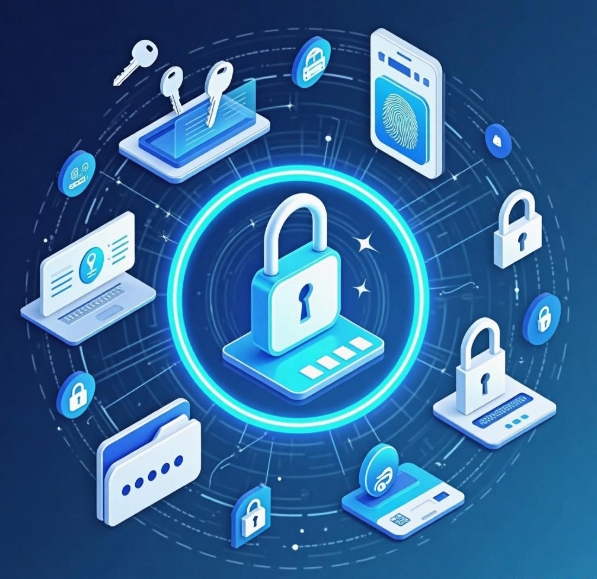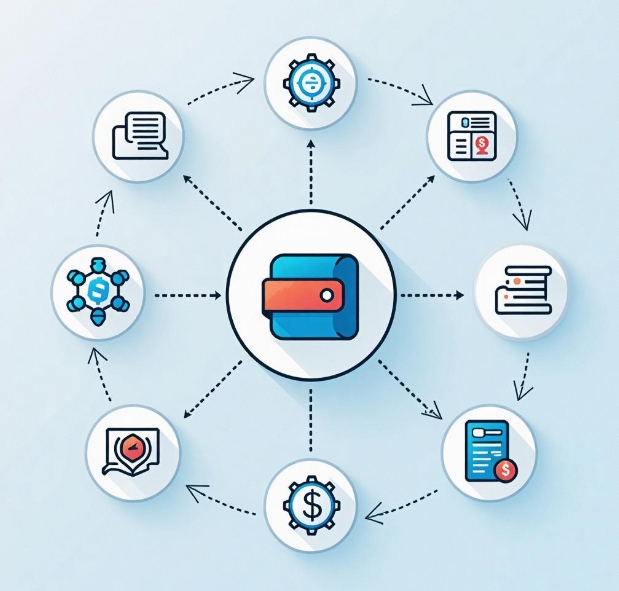Web3 Points Mall User Wallet Interaction Optimization
- latest articles
- 1.DApp Development & Customization: Merging Diverse Market Needs with User Experience 2.Analysis of the Core Technical System in DApp Project Development 3.How to achieve cross-chain interoperability in Web3 projects? 4.How does the tokenization of points reconstruct the e-commerce ecosystem? 5.How to Set and Track Data Metrics for a Points Mall? 6.What is DApp Development? Core Concepts and Technical Analysis 7.Inventory of commonly used Web3 development tools and usage tips 8.Development of a Distribution System Integrated with Social E-commerce 9.Six Key Steps for Businesses to Build a Points Mall System 10.What is DApp Development? A Comprehensive Guide from Concept to Implementation
- Popular Articles
- 1.Future Trends and Technology Predictions for APP Development in 2025 2.Analysis of the DeFi Ecosystem: How Developers Can Participate in Decentralized Finance Innovation 3.From Zero to One: How PI Mall Revolutionizes the Traditional E-commerce Model 4.DAPP Development | Best Practices for Professional Customization and Rapid Launch 5.Recommended by the Web3 developer community: the most noteworthy forums and resources 6.From Cloud Computing to Computing Power Leasing: Building a Flexible and Scalable Computing Resource Platform 7.How to Develop a Successful Douyin Mini Program: Technical Architecture and Best Practices 8.Shared Bike System APP: The Convenient Choice in the Era of Smart Travel 9.How to Create a Successful Dating App: From Needs Analysis to User Experience Design 10.From Design to Development: The Complete Process of Bringing an APP Idea to Life
With the development of blockchain technology, the concept of Web3 is gradually gaining traction, especially as its applications in areas like Decentralized Finance (DeFi) and Non-Fungible Tokens (NFTs) continue to expand. As an innovative business model, Web3 points marketplaces are increasingly appearing in users' lives. In these marketplaces, the user wallet interaction experience is crucial, directly impacting purchasing, redemption, and the overall platform experience. Optimizing the interaction design of user wallets in Web3 points marketplaces not only enhances the user experience but also contributes to the platform's long-term development and user retention.
I. Overview of Web3 Points Marketplaces
A Web3 points marketplace is a decentralized platform based on blockchain technology and smart contracts. Users earn specific points or tokens by participating in platform activities or purchasing goods. These points or tokens can be redeemed for goods, services, or other benefits within the platform, and can even be traded on external exchanges.
Unlike traditional points marketplaces, the core advantage of Web3 points marketplaces lies in their decentralized nature. All platform data and transaction records are collectively maintained by the blockchain network. This ensures that every transaction has a publicly transparent record, and users can easily manage their points and tokens through their wallets.
II. The Role of User Wallets in Web3 Points Marketplaces
User wallets are a core component of Web3 points marketplaces, holding important information such as user points, tokens, and transaction records. Through their wallets, users can conveniently perform operations like earning, redeeming, and transferring points. The decentralized nature of Web3 also dictates that user wallets play a crucial role in this process.
In traditional e-commerce platforms, user account information and points records are typically managed centrally by the platform. However, in Web3 points marketplaces, user wallets act as a "digital identity." All transactions and point redemption operations are completed directly through the wallet, giving users greater control over their assets and enhanced privacy protection.
1. Association Between Wallet and Points
In Web3 points marketplaces, users bind their points accounts to their wallet addresses, allowing them to check their points balance, redemption history, and other information in real-time. Every point earned or spent is recorded via smart contracts and linked to the tokens or points in the user's wallet. This decentralized approach ensures the security of points and the transparency of transactions.
2. Association Between Wallet and Transactions
User wallets are not only used for storing points and tokens but also for executing transactions. In Web3 points marketplaces, users initiate redemption operations, product purchases, and cross-platform trades through their wallets. The wallet's interaction method directly affects the user's purchasing experience. Poor interaction design can lead to confusion and inconvenience during transactions, thereby impacting the overall user experience.
III. Challenges in User Wallet Interaction for Web3 Points Marketplaces
Although Web3 technology offers users greater security and transparency, the interaction experience with user wallets still faces many challenges, especially in the specific context of points marketplaces. The following difficulties are particularly prominent:
1. Interface Complexity
Web3 wallet interfaces are often complex, and for non-technical users, operations can seem cumbersome. For example, users need to manage multiple tokens and assets in their wallets, and each points redemption or product purchase requires multiple confirmation steps. This multi-step process increases the difficulty of operation, especially for first-time Web3 wallet users, many of whom may feel confused and uneasy.
2. Private Keys and Security Issues
In the Web3 ecosystem, wallet security is paramount. A user's wallet private key is the sole credential for their digital assets; if lost or leaked, it can lead to irrecoverable losses. However, many current Web3 wallets do not offer sufficiently simple and secure private key management, and many users still have misconceptions about how to securely store private keys.
3. Volatility of Blockchain Networks
Web3 points marketplaces typically rely on blockchain networks for transactions and settlements, and the latency and volatility of blockchains can lead to an unstable user experience. For instance, some transactions may take a long time to confirm, especially during network congestion, which can cause user dissatisfaction with the marketplace. Therefore, improving transaction response speed and confirmation time is also an important issue in optimizing wallet interaction.
4. User Education
Web3 technology remains a relatively unfamiliar field for many users. Users require some education to understand the basic functions of wallets, how to manage tokens, and how to conduct secure transactions. Currently, most Web3 points marketplaces do not provide sufficient user education, leading to difficulties for many users when using wallets.
IV. Strategies for Optimizing User Wallet Interaction in Web3 Points Marketplaces
To enhance the user wallet interaction experience in Web3 points marketplaces, optimization is needed across multiple dimensions, including interface design, security, and transaction processes. Here are some specific optimization strategies:
1. Simplify the Wallet Interface
A clean and intuitive interface design is the foundation for improving the user experience. In Web3 points marketplaces, the wallet interface should minimize unnecessary complex features and highlight core operations. For example, users should be able to view their points balance, perform token exchanges, and check transaction history at a glance, without needing to switch between different pages or applications multiple times. At the same time, the fluidity of wallet operations should be ensured to avoid user confusion due to interface complexity.
Additionally, using clear icons, explicit labels, and friendly prompts can help users quickly understand various functions. For instance, when users first use the wallet, a guided tutorial can be provided to help them learn how to perform basic operations.
2. Improve Private Key Management
Private key security is one of the core issues in Web3 wallets. To reduce the risk of users losing or leaking their private keys, more secure and convenient private key management methods can be adopted. For example, using seed phrase backups, fingerprint or facial recognition, and other biometric technologies can ensure wallet security. Additionally, wallets should provide multi-factor authentication to ensure the security of transaction operations.
Furthermore, platforms can offer user education to help users understand the importance of private keys and how to properly safeguard them. For example, when users create a wallet for the first time, provide detailed backup guidance and remind them not to disclose their seed phrase or private key to anyone.
3. Enhance Transaction Confirmation Speed
Improving transaction response speed is a key factor in enhancing the user experience. This can be achieved by selecting more efficient blockchain networks to reduce transaction latency. For instance, choosing Layer 2 solutions with high throughput and low transaction costs (such as Optimism, Arbitrum, etc.) can improve transaction efficiency.
Additionally, platforms can optimize transaction processes through smart contracts, reducing unnecessary intermediate steps to make transaction confirmations faster. To address user concerns about transaction confirmation times, the wallet interface can display transaction status in real-time, increasing transparency and reducing user anxiety.
4. User Education and Support
User education is an important component of optimizing Web3 wallet interaction. Platforms can employ various methods to educate users and help them quickly master wallet usage. Specifically, the following approaches can be used:
Provide easy-to-understand tutorials and videos to help users learn basic wallet operations.
Set up a Frequently Asked Questions (FAQ) section to promptly address common user issues.
Integrate customer support features within the wallet to offer instant online consultation and assistance.
Promote the secure use and tips for Web3 wallets through community interactions, social media, and other channels within the platform.
V. Conclusion
Optimizing user wallet interaction in Web3 points marketplaces is key to enhancing the user experience, increasing user retention, and improving platform competitiveness. Through optimizations in simplifying the interface, improving private key management, enhancing transaction speed, and strengthening user education, the user experience in Web3 points marketplaces can be effectively improved, promoting the further development of Web3 business models.
In the future, as blockchain technology and the Web3 ecosystem continue to mature, the interaction design of user wallets will continuously innovate and optimize, providing more efficient, secure, and convenient user experiences, helping users better enjoy the pleasures of decentralized shopping.
-

How does the tokenization of points reconstruct the e-commerce ecosystem?
With the continuous advancement of internet technology and the gradual prolifera···
-

How to Set and Track Data Metrics for a Points Mall?
With the rapid development of the e-commerce industry, points malls, as a common···
-

Development of a Distribution System Integrated with Social E-commerce
With the rapid development of internet technology, the e-commerce industry has e···

 Blockchain
Blockchain












